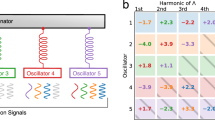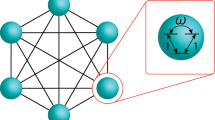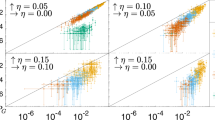Abstract
Quantum simulation has emerged as a valuable arena for demonstrating and understanding the capabilities of near-term quantum computers1,2,3. Quantum annealing4,5 has been successfully used in simulating a range of open quantum systems, both at equilibrium6,7,8 and out of equilibrium9,10,11. However, in all previous experiments, annealing has been too slow to coherently simulate a closed quantum system, due to the onset of thermal effects from the environment. Here we demonstrate coherent evolution through a quantum phase transition in the paradigmatic setting of a one-dimensional transverse-field Ising chain, using up to 2,000 superconducting flux qubits in a programmable quantum annealer. In large systems, we observe the quantum Kibble–Zurek mechanism with theoretically predicted kink statistics, as well as characteristic positive kink–kink correlations, independent of temperature. In small chains, excitation statistics validate the picture of a Landau–Zener transition at a minimum gap. In both cases, the results are in quantitative agreement with analytical solutions to the closed-system quantum model. For slower anneals, we observe anti-Kibble–Zurek scaling in a crossover to the open quantum regime. The coherent dynamics of large-scale quantum annealers demonstrated here can be exploited to perform approximate quantum optimization, machine learning and simulation tasks.
This is a preview of subscription content, access via your institution
Access options
Access Nature and 54 other Nature Portfolio journals
Get Nature+, our best-value online-access subscription
$29.99 / 30 days
cancel any time
Subscribe to this journal
Receive 12 print issues and online access
$209.00 per year
only $17.42 per issue
Buy this article
- Purchase on Springer Link
- Instant access to full article PDF
Prices may be subject to local taxes which are calculated during checkout




Similar content being viewed by others
Data availability
Data supporting the findings of this paper are available from the corresponding author upon request. Source data are provided with this paper.
Code availability
The TEBD code used in this paper is available from the corresponding author upon reasonable request. An open-source version of the PIMC code used in the Supplementary Information is available via GitHub at https://github.com/dwavesystems/dwave-pimc. The version for this work is archived in Zenodo at https://doi.org/10.5281/zenodo.6842260.
References
Kandala, A. et al. Hardware-efficient variational quantum eigensolver for small molecules and quantum magnets. Nature 549, 242–246 (2017).
Zhang, J. et al. Observation of a many-body dynamical phase transition with a 53-qubit quantum simulator. Nature 551, 601–604 (2017).
Keesling, A. et al. Quantum Kibble–Zurek mechanism and critical dynamics on a programmable Rydberg simulator. Nature 568, 207–211 (2019).
Kadowaki, T. & Nishimori, H. Quantum annealing in the transverse Ising model. Phys. Rev. E 58, 5355 (1998).
Johnson, M. W. et al. Quantum annealing with manufactured spins. Nature 473, 194–198 (2011).
Harris, R. et al. Phase transitions in a programmable quantum spin glass simulator. Science 361, 162–165 (2018).
King, A. D. et al. Observation of topological phenomena in a programmable lattice of 1,800 qubits. Nature 560, 456–460 (2018).
Nishimura, K., Nishimori, H. & Katzgraber, H. G. Griffiths-McCoy singularity on the diluted Chimera graph: Monte Carlo simulations and experiments on quantum hardware. Phys. Rev. A 102, 042403 (2020).
Gardas, B., Dziarmaga, J., Zurek, W. H. & Zwolak, M. Defects in quantum computers. Sci. Rep. 8, 4539 (2018).
Bando, Y. et al. Probing the universality of topological defect formation in a quantum annealer: Kibble-Zurek mechanism and beyond. Phys. Rev. Res. 2, 033369 (2020).
Weinberg, P. et al. Scaling and diabatic effects in quantum annealing with a D-Wave device. Phys. Rev. Lett. 124, 090502 (2020).
Dutta, A. et al. Quantum Phase Transitions in Transverse Field Spin Models: From Statistical Physics to Quantum Information (Cambridge Univ. Press, 2015).
Albash, T. & Lidar, D. A. Adiabatic quantum computation. Rev. Mod. Phys. 90, 015002 (2018).
Zurek, W. H. Cosmological experiments in superfluid helium? Nature 317, 505–508 (1985).
Anquez, M. et al. Quantum Kibble-Zurek mechanism in a spin-1 Bose-Einstein condensate. Phys. Rev. Lett. 116, 155301 (2016).
Clark, L. W., Feng, L. & Chin, C. Universal space-time scaling symmetry in the dynamics of bosons across a quantum phase transition. Science 354, 606–610 (2016).
Browaeys, A. & Lahaye, T. Many-body physics with individually controlled Rydberg atoms. Nat. Phys. 16, 132–142 (2020).
Cui, J. M. et al. Experimentally testing quantum critical dynamics beyond the Kibble–Zurek mechanism. Commun. Phys. 3, 44 (2020).
Zurek, W. H., Dorner, U. & Zoller, P. Dynamics of a quantum phase transition. Phys. Rev. Lett. 95, 105701 (2005).
Dziarmaga, J. Dynamics of a quantum phase transition: exact solution of the quantum Ising model. Phys. Rev. Lett. 95, 245701 (2005).
Polkovnikov, A. Universal adiabatic dynamics in the vicinity of a quantum critical point. Phys. Rev. B 72, 161201 (2005).
Cincio, L., Dziarmaga, J., Meisner, J. & Rams, M. M. Dynamics of a quantum phase transition with decoherence: quantum Ising chain in a static spin environment. Phys. Rev. B 79, 094421 (2009).
Arceci, L., Barbarino, S., Rossini, D. & Santoro, G. E. Optimal working point in dissipative quantum annealing. Phys. Rev. B 98, 064307 (2018).
del Campo, A. Universal statistics of topological defects formed in a quantum phase transition. Phys. Rev. Lett. 121, 200601 (2018).
Cherng, R. W. & Levitov, L. S. Entropy and correlation functions of a driven quantum spin chain. Phys. Rev. A 73, 043614 (2006).
Mayo, J. J., Fan, Z., Chern, G.-W. & del Campo, A. Distribution of kinks in an Ising ferromagnet after annealing and the generalized Kibble-Zurek mechanism. Phys. Rev. Res. 3, 033150 (2021).
Krebs, K., Pfannmüller, M. P., Wehefritz, B. & Hinrichsen, H. Finite-size scaling studies of one-dimensional reaction-diffusion systems. Part I. Analytical results. J. Stat. Phys. 78, 1429–1470 (1995).
Roychowdhury, K., Moessner, R. & Das, A. Dynamics and correlations at a quantum phase transition beyond Kibble-Zurek. Phys. Rev. B 104, 014406 (2021).
Nowak, R. J. & Dziarmaga, J. Quantum Kibble-Zurek mechanism: kink correlations after a quench in the quantum Ising chain. Phys. Rev. B 104, 075448 (2021).
Oshiyama, H., Shibata, N. & Suzuki, S. Kibble–Zurek mechanism in a dissipative transverse Ising chain. J. Phys. Soc. Jpn 89, 104002 (2020).
Schuch, N., Wolf, M. M., Verstraete, F. & Cirac, J. I. Entropy scaling and simulability by matrix product states. Phys. Rev. Lett. 100, 030504 (2008).
Dziarmaga, J. Dynamics of a quantum phase transition and relaxation to a steady state. Adv. Phys. 59, 1063–1189 (2010).
Zanca, T. & Santoro, G. E. Quantum annealing speedup over simulated annealing on random Ising chains. Phys. Rev. B 93, 224431 (2016).
Zener, C. Non-adiabatic crossing of energy levels. Proc. R. Soc. Lond. A 137, 696–702 (1932).
Kato, T. On the adiabatic theorem of quantum mechanics. J. Phys. Soc. Jpn 5, 435–439 (1950).
Isakov, S. V. et al. Understanding quantum tunneling through quantum Monte Carlo simulations. Phys. Rev. Lett. 117, 180402 (2016).
Mazzola, G., Smelyanskiy, V. N. & Troyer, M. Quantum Monte Carlo tunneling from quantum chemistry to quantum annealing. Phys. Rev. B 96, 134305 (2017).
Suzuki, M. Relationship between d-dimensional quantal spin systems and (d+1)-dimensional Ising systems: equivalence, critical exponents and systematic approximants of the partition function and spin correlations. Prog. Theor. Phys. 56, 1454–1469 (1976).
Liu, C. W., Polkovnikov, A. & Sandvik, A. W. Quantum versus classical annealing: insights from scaling theory and results for spin glasses on 3-regular graphs. Phys. Rev. Lett. 114, 147203 (2015).
King, A. D. et al. Scaling advantage over path-integral Monte Carlo in quantum simulation of geometrically frustrated magnets. Nat. Commun. 12, 1113 (2021).
Bando, Y. & Nishimori, H. Simulated quantum annealing as a simulator of nonequilibrium quantum dynamics. Phys. Rev. A 104, 022607 (2021).
Yip, K. W., Albash, T. & Lidar, D. A. Quantum trajectories for time-dependent adiabatic master equations. Phys. Rev. A 97, 022116 (2018).
Acknowledgements
We thank H. Oshiyama, N. Shibata, A. del Campo, L. Addario-Berry, T. Albash and A. W. Sandvik for fruitful discussions, and acknowledge the contributions of both technical and non-technical staff at D-Wave. We acknowledge the Center for Advanced Research Computing (CARC) at the University of Southern California for providing computing resources that have contributed to the research results reported within this publication. URL: https://carc.usc.edu. DAL acknowledges support from the National Science Foundation ‘the Quantum Leap Big Idea’ under Grant No. OMA-1936388, and by DARPA under the RQMLS program, Agreement No. HR00112190071.
Author information
Authors and Affiliations
Contributions
A.D.K., S.S., J.R., A.Z., T.L. F.A., A.J.B., S.E., R.H., D.A.L., H.N. and M.H.A. conceived and designed the experiments and analysed the data. A.D.K., S.S., J.R., A.Z., T.L. and R.H. performed the experiments. T.L., F.A., A.J.B., S.E., E.H., S.H., E.L., A.J.R.M., G.M., T.O., G.P.-L., M.R., C.R., Y.S., J.D.W., J.Y., R.H. and M.H.A. contributed to the design, fabrication, deployment and calibration of the quantum annealing system. A.D.K., S.S., J.R., D.A.L., H.N. and M.H.A. wrote the manuscript.
Corresponding author
Ethics declarations
Competing interests
S.S., D.A.L. and H.N. declare no competing interests. A.D.K., J.R., A.Z., T.L., F.A., A.J.B., S.E., E.H., S.H., E.L., A.J.R.M., G.M., T.O., G.P.-L., M.R., C.R., Y.S., J.D.W., J.Y., R.H. and M.H.A. affiliated with D-Wave hold stock options in D-Wave and declare a competing financial interest on that basis.
Peer review
Peer review information
Nature Physics thanks Guglielmo Mazzola, David Bernal Neira and the other, anonymous, reviewer(s) for their contribution to the peer review of this work.
Additional information
Publisher’s note Springer Nature remains neutral with regard to jurisdictional claims in published maps and institutional affiliations.
Supplementary information
Supplementary Information
Supplementary Figs. 1–16 and Sections A–F.
Source Data Fig. 2
Source data for Fig. 2.
Source Data Fig. 3
Source data for Fig. 3.
Source Data Fig. 4
Source data for Fig. 4.
Rights and permissions
Springer Nature or its licensor holds exclusive rights to this article under a publishing agreement with the author(s) or other rightsholder(s); author self-archiving of the accepted manuscript version of this article is solely governed by the terms of such publishing agreement and applicable law.
About this article
Cite this article
King, A.D., Suzuki, S., Raymond, J. et al. Coherent quantum annealing in a programmable 2,000 qubit Ising chain. Nat. Phys. 18, 1324–1328 (2022). https://doi.org/10.1038/s41567-022-01741-6
Received:
Accepted:
Published:
Issue Date:
DOI: https://doi.org/10.1038/s41567-022-01741-6
This article is cited by
-
Short-depth QAOA circuits and quantum annealing on higher-order ising models
npj Quantum Information (2024)
-
The promises and challenges of many-body quantum technologies: A focus on quantum engines
Nature Communications (2024)
-
Review of Applications of Quantum Computing in Power Flow Calculation
Journal of Electrical Engineering & Technology (2024)
-
Calculating Nash equilibrium on quantum annealers
Annals of Operations Research (2024)
-
Efficient combinatorial optimization by quantum-inspired parallel annealing in analogue memristor crossbar
Nature Communications (2023)



